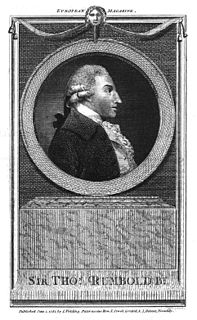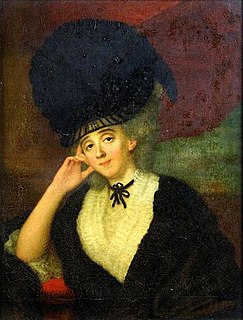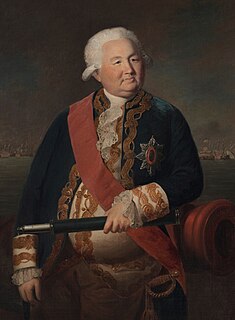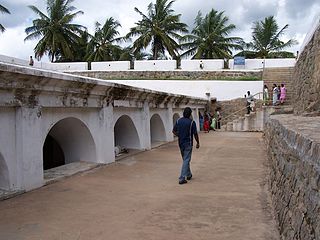Related Research Articles

Tipu Sultan, also known as the Tiger of Mysore, was the ruler of the Kingdom of Mysore based in South India. He was a pioneer of rocket artillery. He introduced a number of administrative innovations during his rule, including a new coinage system and calendar, and a new land revenue system, which initiated the growth of the Mysore silk industry. He expanded the iron-cased Mysorean rockets and commissioned the military manual Fathul Mujahidin. He deployed the rockets against advances of British forces and their allies during the Anglo-Mysore Wars, including the Battle of Pollilur and Siege of Srirangapatna, but the British took over the fort.

Hyder Ali, Haidarālī was the Sultan and de facto ruler of the Kingdom of Mysore in southern India. Born as Hyder Ali, from teeli cast of muslims, he distinguished himself as a soldier, eventually drawing the attention of Mysore's rulers. Rising to the post of Dalavayi (commander-in-chief) to Krishnaraja Wodeyar II, he came to dominate the titular monarch and the Mysore government. He became the de facto ruler of Mysore as Sarvadhikari by 1761. During intermittent conflicts against the East India Company during the First and Second Anglo–Mysore Wars, Hyder Ali was a military leader.

The Battle of Pollilur, also known as the Battle of Polilore or Battle of Perambakam, took place on 10 September 1780 at Pollilur near Conjeevaram, the city of Kanchipuram in present-day Tamil Nadu state, India, as part of the Second Anglo-Mysore War. It was waged between two forces commanded by Tipu Sultan of the Kingdom of Mysore, and Lt. Colonel William Baillie of the British East India Company. The army of the East India Company surrendered and suffered a high number of casualties. It is considered as the worst loss the East India Company suffered on the subcontinent. Benoît de Boigne, a French officer in the service of 6th Regiment of Madras Native Infantry, wrote, "There is not in India an example of a similar defeat".

The Second Anglo-Mysore War was a conflict between the Kingdom of Mysore and the British East India Company from 1780 to 1784. At the time, Mysore was a key French ally in India, and the conflict between Britain against the French and Dutch in the American Revolutionary War sparked Anglo-Mysorean hostilities in India. The great majority of soldiers on the company side were raised, trained, paid and commanded by the company, not the British government. However, the company's operations were also bolstered by Crown troops sent from Britain, and by troops from Hanover, which was also ruled by Britain's King George III.

The First Anglo-Mysore War (1766–1769) was a conflict in India between the Sultanate of Mysore and the East India Company. The war was instigated in part by the machinations of Asaf Jah II, the Nizam of Hyderabad, who sought to divert the company's resources from attempts to gain control of the Northern Circars.

The Anglo-Mysore Wars were a series of wars fought during the last three decades of the 18th century between the Kingdom of Mysore on the one hand, and the British East India Company, Maratha Empire, Kingdom of Travancore and the Nizam of Hyderabad on the other. Hyder Ali and his successor Tipu Sultan fought a war on four fronts with the British attacking from the west, south and east, while the Nizam's forces attacked from the north. The fourth war resulted in the overthrow of the house of Hyder Ali and Tipu, and the dismantlement of Mysore to the benefit of the East India Company, which took control of much of the Indian subcontinent.

George Pigot, 1st Baron Pigot was twice the British President of the British East India Company.

Sir Thomas Rumbold, 1st Baronet was a British administrator in India and politician who sat in the House of Commons between 1770 and 1790. He served as Governor of Madras from 1777 to 1780. He became infamous for his corruption and, for in effect stealing, the ring of the Nawab of Arcot. He brought home from India 1.5 million pagodas or about £600,000 and was a classic example of a nabob. Attempts were made to investigate the misdemeanour by Henry Dundas but the case did not make much headway.

Major-General James Stuart was a British Army officer who served in various conflicts in India during the 18th century. His service in the East India Company was marked by his conflict with Lord Pigot, the governor of Madras; Stuart's arrest of the latter in 1776 resulted in his suspension as commander-in-chief, and he was not vindicated until 1780. He later fought in the Second Anglo-Mysore War, but was suspended from command in 1782 by Lord Macartney, an action that provoked a duel between the two men. Stuart was a younger brother of the lawyer and politician Andrew Stuart.

Eliza Draper is best known as Laurence Sterne's Eliza. She was his muse and is commemorated in his Sentimental Journey and Journal to Eliza. She had literary talents which were developed under Sterne's influence and she wrote many long and interesting letters from India, vividly describing the life and customs there.

The CarnaticSultanate was a kingdom in South India between about 1690 and 1855, and was under the legal purview of the Nizam of Hyderabad, until their demise. They initially had their capital at Arcot in the present-day Indian state of Tamil Nadu. Their rule is an important period in the history of the Carnatic and Coromandel Coast regions, in which the Mughal Empire gave way to the rising influence of the Maratha Empire, and later the emergence of the British Raj.

Muhammad Ali Khan Wallajah, or Muhammed Ali, Wallajah, was the Nawab of Arcot in India and an ally of the British East India Company.
The Treaty of Mangalore was signed between Tipu Sultan and the British East India Company on 11 March 1784. It was signed in Mangalore and brought an end to the Second Anglo-Mysore War.

The Siege of Negapatam was the first major offensive military action on the Indian subcontinent following the arrival of news that war had been declared between Great Britain and the Dutch Republic, beginning the Fourth Anglo-Dutch War. A British force besieged the Dutch-controlled port of Negapatam, the capital of Dutch Coromandel, on the eastern coast of India, which capitulated after the fortification's walls were breached. The Dutch garrison consisted of 500 European troops, 5,500 local troops, and 2,000 troops of Hyder Ali, the ruler of Mysore.

South Arcot District was a district in the Madras Presidency of British India. It covered the area of the present-day districts of Cuddalore, Kallakurichi and Viluppuram in the Indian state of Tamil Nadu. The district was divided into eight taluks and covered a total area of 13,510 square kilometres (5,217 sq mi). The administrative headquarters was the town of Cuddalore.

William Baillie was a British lieutenant-colonel in the East India Company's service. He was captured by Hyder Ali in 1780 at the Battle of Pollilur, and died in captivity in Seringapatam.

The Mysorean invasion of Malabar was the military invasion of the Malabar region of the current Kerala state, including the territories of the Zamorin of Calicut, by the de facto ruler of the Kingdom of Mysore, Hyder Ali. After the invasion, the Kingdom of Cochin south of Malabar became a tributary state of Mysore.
The Treaty of Madras was a peace agreement signed on 4 April 1769 between Mysore and the British East India Company which brought an end to the First Anglo-Mysore War. Fighting had broken out in 1767 and the forces of Hyder Ali had come close to capturing Madras at one point.

The Battle of Tiruvannamalai is one of the two successful battles fought by the Madras Army in the Carnatic along with the Battle of Chengam. It was fought on 25 September 1767 between the allied forces led by the East India Company against the troops of Hyder Ali. The allied forces of the English army were led by Colonel Smith.
George Stratton was an East India Company official and politician who sat in the House of Commons between 1778 and 1784.
References
- ↑ British India Office Parish register transcripts from the Presidency of Bombay, 1709-1948
- 1 2 Prinsep, Charles Campbell. "Record of services of the Honourable East India Company's civil servants in the Madras presidency, from 1741 to 1858... comp. and ed. from records in the possession of the Secretary of state for India (Madras Civil Servants)". Trübner, London.
- 1 2 3 4 5 Sclater, William Lutley (1922). Sterne's Eliza; some account of her life in India: with her letters written between 1757 and 1774. London: W. Heinemann. p. 157-171.
- ↑ "STRATTON, George (?1734-1800), of Great Tew, Oxon". History of Parliament Online. Retrieved 1 November 2017.
- 1 2 3 Prinsep, Charles Campbell. "Record of services of the Honourable East India Company's civil servants in the Madras presidency, from 1741 to 1858... comp. and ed. from records in the possession of the Secretary of state for India (governors of Madras)". Trübner, London.
- 1 2 Bowring, p. 88
- ↑ Bowring, pp. 88–89
- ↑ Bowring, pp. 90–91
- ↑ Bowring, p. 92
- ↑ Bowring, p. 93
Bowring, Lewin (1899). Haidar Alí and Tipú Sultán, and the Struggle with the Musalmán Powers of the South. Oxford: Clarendon Press. OCLC 11827326.